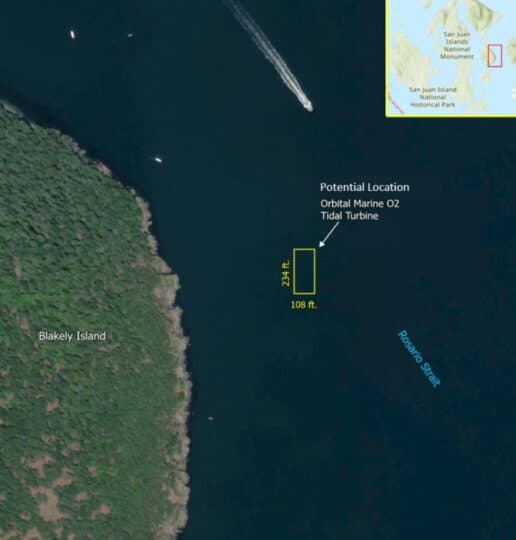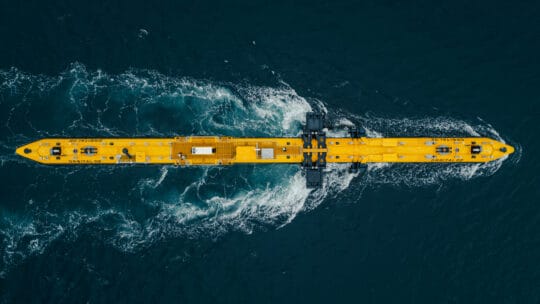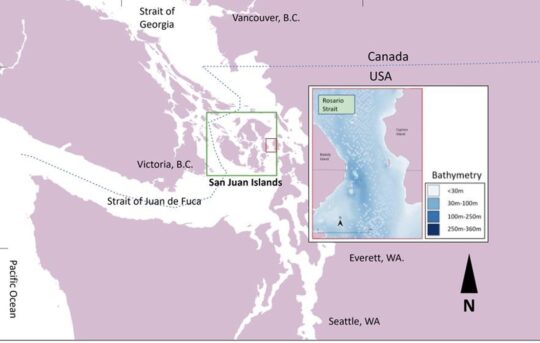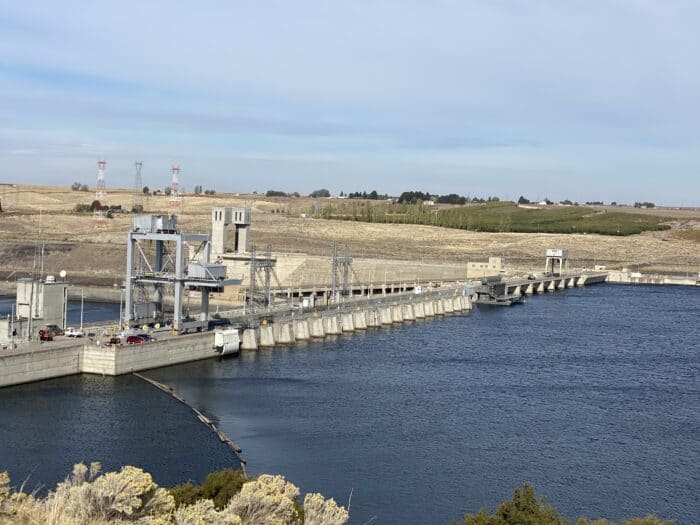Quick Fact: OPALCO Tidal Energy Pilot Project
ABOUT this project:
On March 27, 2025, OPALCO filed a Draft License Application with the Federal Energy Regulatory Commission (FERC) for a 10-year pilot project license for OPALCO’s proposed Rosario Strait Tidal Energy Project. The Draft License Application compiles the best available science, presents the results of the site characterization studies, and includes a discussion of existing conditions affects analysis. This is only the beginning of the analysis needed to get to a Final License Application. The work to date is not considered complete and is at a point where key areas will be identified for further study and analysis.
OPALCO has been selected as one of two finalists for ~$30M in funding through Department of Energy (DOE). Due to delays from DOE, the decision is not expected before January 2026. OPALCO is requesting and was granted a delay in the FERC process to avoid further investment of time and resources by OPALCO, FERC, resource agencies, Tribal Nations and stakeholders until project funding has been secured.
Given our unique service territory in the San Juan Islands, surrounded by the Salish Sea, people have been asking for years why we haven’t explored tidal energy yet. A combination of a 2021 Department of Commerce grant and a 2024 Department of Energy grant has given us an opportunity to study what a project like this could mean. If this project were to move forward, there are still lots of studies, research, and analysis to be done to make sure this is a viable energy source for this region and that it meets the criteria for success on all fronts.

Through a US DOE TEAMER project, OPALCO and our project partners have explored siting of a ~2MW floating tidal stream Orbital Marine Power turbine. The Rosario Strait, near Blakely Island, WA was identified as a viable site with strong tidal flows in proximity to OPALCO infrastructure for interconnection. For the chosen site the interconnection would be via an existing 18” conduit that was installed in 2004 from OPALCO underground vault on northwest Blakely Island and Southeast of Orcas Island to the sea floor. The interconnection would connect to a substation on Blakely Island where the energy would be transmitted via OPALCO’s 69kV transmission system to subsequent islands. It is estimated that one Orbital tidal turbine would be able to power 400 homes in the OPALCO service territory. Estimated annual production is anticipated to be 4.6 to 5.6 GWh.
WHY are we exploring tidal and other renewables?
We’re seeing an imbalance in supply and demand that can that could greatly affect our region. As an island community, San Juan County is at risk of unreliable electricity, as the vast majority of OPALCO’s power comes from submarine cables from mainland WA state. Because of this, OPALCO is committed to implementing local energy generation resources that strengthen the resilience of infrastructure, increase safety and reliability for the co-op members, and keep rates affordable. We also want to ensure that our future energy supply is carbon free to mitigate the impacts of climate change. This is especially important as the US rushes to decarbonize and has been decommissioning coal power plants. OPALCO is looking to meet the goal of providing reliable and resilient power during a time when existing energy sources are being taken off the grid, while still meeting regulatory clean energy goals.
For more information on the growing supply vs. demand issue in our region, visit the Quick Fact: Why Local Renewable Projects? Mainland Power Demand will Soon Exceed Supply.
THE TECH: Orbital Marine Floating Tidal Turbine

The Orbital Marine Power O2 floating tidal turbine has a 242- foot hull with suspended rotors underneath that can be raised for on-site service. The turbine is anchored to the seafloor with mooring lines (See image to right). Floating approximately 5 feet above the waterline and 7.5 feet below, the unit houses two turbines with a combined output of ~2 MW. The device is 197 feet wide including the span of the blades when raised above water. This technology has been deployed since 2021 in the Orkney Islands, Scotland. It is the third grid connected device that Orbital has installed. The Orkney Islands has a similar marine environment to San Juan Islands including pods of Orca Whales. There has been consistent monitoring and no Orca interaction with the device to date. While lessons from the Orkney pilot are informative and will be applied to OPALCO’s project, the Rosario Strait project will undergo its own scientific monitoring and mitigation requirements (as identified in the Draft License Application), ensuring locally relevant data informs every stage of design, construction, and operation. Projects like this turbine would be built and sourced in the USA.
THE DETAILS: Grants and studies completed
In 2018 OPALCO began investigations of multiple tidal device types and deployment logistics in the San Juan Islands. OPALCO found the floating turbine technology to have the most promise considering the service ability, marine traffic and environmental parameters.
Below are details about the work done from 2019-2021, including the Department of Commerce grant.
- Established relationship via MOU with Orbital Marine Power in Q1 2021 with informal exchange of information having previously started in mid-2019.
- PNNL and Orbital awarded US DOE TEAMER Grant (PNNL-32302, Environmental Information for Siting and Operation of Floating Tidal Turbines in U.S. Waters) Site assessment study completed Q4 2021.
- University of Washington and Orbital awarded US DOE TEAMER Grant (Orbital Marine Power, San Juan Islands Tidal Energy Characterization, Facility: University of Washington and Pacific Northwest National Laboratory).
- OPALCO awarded WA DOC CEF4 Grid Modernization Grant in Q4 2021 for preliminary design and permitting of floating tidal generation in Rosario Strait.
- Pacific Northwest National Labs siting study evaluated five different locations around the San Juan Islands and Rosario Strait was chosen for a variety of factors including less marine mammal traffic and close to existing infrastructure.

The 2024 DOE grant is for feasibility only and is competitive. This grant is only phase one of multiple grant funding phases that would be necessary in order for the project to be successful, if it were to move forward. The 12 month grant period officially started in June 2024. The feasibility study for this grant, which evaluates whether or not this project would be successful, includes:
- Environmental site study for physical and biological data that includes mapping the sea floor, assessing tidal flow, monitoring tagged fish going through the area, and measuring underwater noise levels
- Environmental risk register using a third-party objective analysis that evaluates key issues the project will face
- Draft License Application to Federal Energy Regulatory Commission (FERC)
- Community Outreach
OPALCO has had ongoing engagement with:
- Local, state, and federal agencies
- Tribal Sovereign Nations
- Local Stakeholders
- OPALCO members
TRIBAL ENGAGEMENT:
Engagement and collaboration with the Tribal Nations is a key aspect of project development. OPALCO recognizes that the Tribal Nations with ancestral lands in the San Juan Islands have strong spiritual and cultural ties to salmon and other aquatic species in the region that includes thousands of years of access and use for religious/cultural ceremonies, subsistence, and for commercial purposes. The proposed project would be in the Usual and Accustomed (U&A) fishing area for the region’s Tribal Nations who were signatory to the Treaty of Point Elliott, which is a key aspect of why OPALCO started outreach to the Tribal Nations at the inception of the feasibility study. OPALCO began outreach and hosting meetings with Tribal Nations in 2022. OPALCO continued engagement through meetings and correspondence at key milestones throughout the duration of the Department of Energy Phase 1 grant process to share information about the potential project and collaborate to assess the feasibility. OPALCO worked collaboratively with Tribal Nations to identify priority topics requiring study to inform the FERC Draft License Agreement (DLA) application process. In March 2025, OPALCO filed the DLA application with the Federal Regulatory Commission (FERC). Government-to-government consultation with the Tribal Nations will occur between FERC and the Tribal Nations.
Since 2022, OPALCO has been meeting with the Tribal Nations to engage them on this project and to obtain their early input to help shape the project. OPALCO had 92 “touch points” with the Tribal Nations during this time. OPALCO values these long-standing tribal partnerships and appreciates the meaningful input and collaboration that have been received so far, including collaboration on kelp restoration efforts in the vicinity of the project, valuable information on the importance of tribal treaty fishing rights, and tribal perspectives on renewable projects in general.
OPALCO appreciated that the Swinomish Tribe let us know that they submitted a formal objection to the project with FERC on September 30 (additionally two other tribes filed objections). The objections raise concerns about the impacts the project will have on the Usual & Accustomed Fishing Rights and the sensitive marine environment. The Tribe also stated some of the bigger regional issues with old docks and other marine equipment that lingers in the waters will need to be addressed before adding in more infrastructure. The OPALCO Team takes feedback from the Tribal Nations seriously and appreciates the time they took to provide input. OPALCO knows that the success of this project or projects like this in the future will rely on the support and collaboration with the Tribal Nations.
OPALCO will heavily consider any tribal objection as they weigh out the potential of this project. The Department of Energy, who is the current funder of the project, is deciding which tidal energy project will receive future funding and will let OPALCO know later this year the decision of the down select process. At that time the Board will consider all the factors of what makes this project viable or not.
Wrapping Up the grant cycle:
On March 27, 2025, OPALCO filed a Draft License Application with the Federal Energy Regulatory Commission (FERC) for a 10-year pilot project license for OPALCO’s proposed Rosario Strait Tidal Energy Project. The Draft License Application compiles the best available science, presents the results of the site characterization studies, and includes a discussion of existing conditions affects analysis but is only the beginning of the analysis needed to get to a Final License application. The work to date is not considered complete but is at a point where key areas will be identified for further study. Based on the government-to-government consultation results and the public comments, FERC will decide on next steps and whether to advance the project to the Final License Application (FLA) for the pilot project.
September 30, 2025 was the last day to make public comments on the Rosario Tidal Energy Project as part of the public process with a pilot Draft License Application (DLA) with the Federal Energy Regulatory Commission (FERC). Future funding is currently dependent on Department of Energy (DOE) and is being determined but is still months away from a decision (as of 9/30/25).
OPALCO remains firmly committed to financial responsibility and environmental stewardship. Local, renewable energy projects need to be technically, environmentally, and fiscally sound. If this project were to move forward, there are still lots of studies, research, and analysis to be done to make sure this is a viable energy source for this region and that it meets the criteria for success on all fronts.
Historically, OPALCO explored a different tidal energy project in the early 1980s. Tidal energy has great potential to supply us with carbon-free energy in this area – especially valuable during the winter and night hours. By providing renewable power locally, the project and projects like this could reduce reliance on carbon-based energy generation and long-distance, dam-generated, energy imports, leading to broader environmental benefits for marine mammals.
Additional Resources:
- January 2025 Tidal Town Halls Public Comments
- Tidal Energy Informational Posters January 2025
- August 2024 Island Way Workshop
- August 2024 Presentation
- Tribal Engagement Summary April 2025
- Tidal Energy Flyer
- PNNL Report on Tidal Energy in San Juan County
- March 2023 OPALCO Member Presentation
- Orbital Marine
- March 2023 Island Way Workshop: Tidal Energy
- Orcas Power and Light Cooperative Tidal Preliminary Assessment and Planning Project (Washington State Department of Commerce Clean Energy Fund)
- Orbital Marine has done studies as part of their siting and permitting process. You will find a map of their project, permit application, dredging/drilling details, navigational risk assessment, project monitoring program, and project information document. Every location will have slightly different environmental factors and each area needs to be looked at individually. Find their information: https://marine.gov.scot/node/24693
- Tidal Generation 2023 Grant Submittal
- Documentary on the Tidal Project
- State of Science: Marine Renewable Energy Report (2024)
- Draft License Application with FERC Project No.15368
- Q&A Video with OPALCO Leadership



